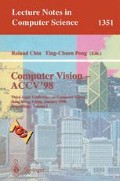Abstract
A method for modelling and recognising facial identity is described within the context of an integrated system for face recognition in dynamic scenes. Recognition is based sequences rather than isolated images. Mixture models provide estimates of class-conditional probabilities and these are used to accumulate recognition confidence over time. Results are presented using data from the integrated system.
Preview
Unable to display preview. Download preview PDF.
References
P. N. Belhumeur, J. P. Hespanha, and D. J. Kriegman. Eigenfaces vs. fisherfaces: recognition using class specific linear projection. IEEE PAMI, 19(7):711–720, 1997.
D. Beymer and T. Poggio. Face recognition from one example view. Technical Report 1536, MIT AI Memo, September 1995.
D. Beymer and T. Poggio. Image representations for visual learning. Science, 272:1905–1909, 28 June 1996.
M. Bichsel and A. P. Pentland. Human face recognition and the face image set's topology. CVGIP: Image Understanding, 59(2):254–261, March 1994.
N. Costen, I. Craw, G. Robertson, and S. Akamatsu. Automatic face recognition: what representation ? In ECCV, pages 504–513, Cambridge, England, April 1996.
K. Etemad and R. Chellappa. Discriminant analysis for recognition of human face images. In AVBPA, pages 127–142, 1997.
G. E. Hinton, P. Dayan, and M. Revow. Modeling the manifolds of images of handwritten digits. IEEE Trans. Neural Networks, 8(1):65–74, 1997.
M. Kirby and L. Sirovich. Application of the karhunen-loeve procedure for the characterization of human faces. IEEE PAMI, 12(1), 1990.
S. J. McKenna and S. Gong. Tracking faces. In Proc. 2nd Int. Conf. on Automatic Face and Gesture Recognition, Killington, Vermont, US, October 1996.
S. J. McKenna, S. Gong, and J. J. Collins. Face tracking and pose representation. In BMVC, Edinburgh, Scotland, September 1996.
S. J. McKenna, S. Gong, and Y. Raja. Face recognition in dynamic scenes. In BMVC, 1997.
A. Pentland, B. Moghaddam, and T. Starner. View-based and modular eigenspaces for face recognition. In CVPR, 1994.
Y. Raja, S. J. McKenna, and S. Gong. Segmentation and tracking using colour mixture models. In ACCV, 1998.
R. A. Redner and H. F. Walker. Mixture Densities, Maximum Likelihood and the EM Algorithm. SIAM Review, 26(2):195–239, 1984.
D. L. Swets and J. Weng. Discriminant analysis and eigenspace partition tree for face and object recognition from views. In Proc. 2nd Int. Conf. on Automatic Face and Gesture Recognition, pages 192–197, 1996.
M. Turk and A. Pentland. Eigenfaces for recognition. J. of Cognitive Neuroscience, 3(1), 1991.
Author information
Authors and Affiliations
Editor information
Rights and permissions
Copyright information
© 1997 Springer-Verlag Berlin Heidelberg
About this paper
Cite this paper
McKenna, S.J., Gong, S. (1997). Face recognition from sequences using models of identity. In: Chin, R., Pong, TC. (eds) Computer Vision — ACCV'98. ACCV 1998. Lecture Notes in Computer Science, vol 1351. Springer, Berlin, Heidelberg. https://doi.org/10.1007/3-540-63930-6_161
Download citation
DOI: https://doi.org/10.1007/3-540-63930-6_161
Published:
Publisher Name: Springer, Berlin, Heidelberg
Print ISBN: 978-3-540-63930-5
Online ISBN: 978-3-540-69669-8
eBook Packages: Springer Book Archive

